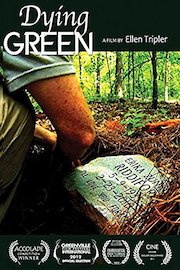-
Genres
-
DirectorEllen Tripler
-
Release Date2013
-
Runtime23 min

Dying Green is a 2012 documentary film directed by Ellen Tripler that explores the concept of environmentally friendly burials as an alternative to traditional burial practices. The film takes an in-depth look at a growing movement towards natural burial, also known as green burial, which involves burying the deceased in a way that has little to no negative impact on the environment.
Throughout the film, viewers are introduced to several individuals who have chosen to embrace this alternative burial method for their loved ones. One of the most compelling stories in the film is that of Judith, a woman who lost her husband and decided to bury him in a green cemetery. Judith shares her experiences with the process of arranging a green burial, and how it ultimately helped her to deal with her grief.
The film also explores some of the environmental benefits of green burials. Traditional burial methods often involve embalming fluids, caskets made from non-biodegradable materials, and large burial plots that can take up valuable land. In contrast, green burials do not involve embalming, and use biodegradable caskets or shrouds. Furthermore, green cemetery plots are usually smaller and can be used for other purposes once the body has fully decomposed.
One of the most interesting aspects of Dying Green is the way in which it challenges traditional attitudes towards death and burial. The film asks viewers to reconsider the way we approach death and how we can make choices that are both personally meaningful and environmentally responsible. By highlighting the experiences of those who have chosen green burial, the film raises important questions about the impact of death on the environment and how we can reduce that impact.
Throughout the film, viewers are also introduced to a number of experts who have studied the environmental impact of traditional burial practices. These experts share their research and explain how green burials can help to reduce the carbon footprint of death. For example, one expert explains that in the United States alone, traditional burials emit over 4 million tons of carbon dioxide each year, which is equivalent to the emissions of over 800,000 cars.
Dying Green also takes viewers behind the scenes to explore the day-to-day workings of a green cemetery. Viewers witness the process of preparing a grave site, including digging the grave by hand and ensuring that the soil is healthy and conducive to decomposition. The film also examines the impact of green cemeteries on local wildlife, including the plants and animals that thrive in these natural environments.
One of the most powerful messages of the film is the idea that death can be a positive force for change. By choosing green burials, individuals can make a tangible difference in the environment and leave a positive legacy for future generations. The film encourages viewers to think about their own end-of-life plans and consider the environmental impact of their choices.
Overall, Dying Green provides a thought-provoking and moving exploration of an alternative approach to burial that is as beneficial to the environment as it is meaningful to those left behind. The film offers a fresh perspective on death and dying, and encourages viewers to consider how they can make a positive impact on the world even after they are gone.
Dying Green is a 2013 documentary with a runtime of 23 minutes.